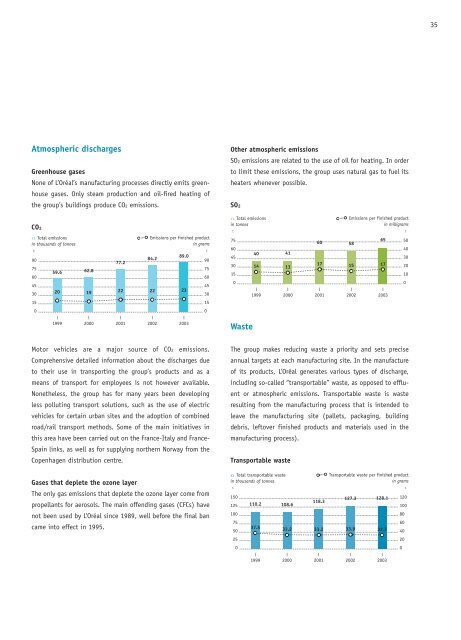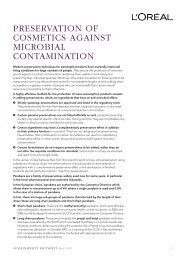Download 2003 Sustainable Development Report (PDF)
Download 2003 Sustainable Development Report (PDF)
Download 2003 Sustainable Development Report (PDF)
You also want an ePaper? Increase the reach of your titles
YUMPU automatically turns print PDFs into web optimized ePapers that Google loves.
35<br />
Atmospheric discharges<br />
Greenhouse gases<br />
None of L’Oréal’s manufacturing processes directly emits greenhouse<br />
gases. Only steam production and oil-fired heating of<br />
the group’s buildings produce CO2 emissions.<br />
Other atmospheric emissions<br />
SO2 emissions are related to the use of oil for heating. In order<br />
to limit these emissions, the group uses natural gas to fuel its<br />
heaters whenever possible.<br />
SO2<br />
CO2<br />
n Total emissions<br />
in thousands of tonnes<br />
t<br />
90<br />
75<br />
60<br />
45<br />
30<br />
15<br />
59.6<br />
62.8<br />
77.2<br />
Emissions per finished product<br />
in grams<br />
84.2<br />
89.0<br />
20 22 22 23<br />
19<br />
tx<br />
90<br />
75<br />
60<br />
45<br />
30<br />
15<br />
n Total emissions<br />
in tonnes<br />
t<br />
75<br />
60<br />
45<br />
30<br />
15<br />
0<br />
40<br />
14<br />
I<br />
1999<br />
41<br />
13<br />
I<br />
2000<br />
60 58<br />
17 15<br />
I<br />
2001<br />
Emissions per finished product<br />
in milligrams<br />
I<br />
2002<br />
65<br />
17<br />
I<br />
<strong>2003</strong><br />
tx<br />
50<br />
40<br />
30<br />
20<br />
10<br />
0<br />
0<br />
I<br />
1999<br />
I<br />
2000<br />
I<br />
2001<br />
I<br />
2002<br />
I<br />
<strong>2003</strong><br />
0<br />
Waste<br />
Motor vehicles are a major source of CO2 emissions.<br />
Comprehensive detailed information about the discharges due<br />
to their use in transporting the group’s products and as a<br />
means of transport for employees is not however available.<br />
Nonetheless, the group has for many years been developing<br />
less polluting transport solutions, such as the use of electric<br />
vehicles for certain urban sites and the adoption of combined<br />
road/rail transport methods. Some of the main initiatives in<br />
this area have been carried out on the France-Italy and France-<br />
Spain links, as well as for supplying northern Norway from the<br />
Copenhagen distribution centre.<br />
Gases that deplete the ozone layer<br />
The only gas emissions that deplete the ozone layer come from<br />
propellants for aerosols. The main offending gases (CFCs) have<br />
not been used by L’Oréal since 1989, well before the final ban<br />
came into effect in 1995.<br />
The group makes reducing waste a priority and sets precise<br />
annual targets at each manufacturing site. In the manufacture<br />
of its products, L’Oréal generates various types of discharge,<br />
including so-called “transportable” waste, as opposed to effluent<br />
or atmospheric emissions. Transportable waste is waste<br />
resulting from the manufacturing process that is intended to<br />
leave the manufacturing site (pallets, packaging, building<br />
debris, leftover finished products and materials used in the<br />
manufacturing process).<br />
Transportable waste<br />
n Total transportable waste<br />
in thousands of tonnes<br />
t<br />
150<br />
125<br />
100<br />
75<br />
50<br />
25<br />
0<br />
110.2<br />
I<br />
1999<br />
108.6<br />
I<br />
2000<br />
118.3<br />
I<br />
2001<br />
Transportable waste per finished product<br />
in grams<br />
127.3 128.1<br />
37.5 33.2 33.2 33.9 32.7<br />
I<br />
2002<br />
I<br />
<strong>2003</strong><br />
tx<br />
120<br />
100<br />
80<br />
60<br />
40<br />
20<br />
0



